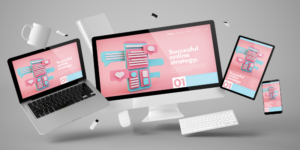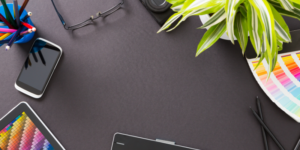Design aesthetics are constantly evolving, and one of the most notable changes we have witnessed in recent decades is the transition from minimalism to maximalism. Minimalism, characterized by its simplicity, cleanliness, and use of white space, has dominated the design scene for a long period. However, in recent years, we have observed a return to more extravagant, lavish, and visually rich aesthetics.
In this article, we will explore the shift in design aesthetics from minimalism to maximalism, understand the reasons behind this transition, and analyze how this change impacts the field of design.
Minimalism: Less is More
Minimalism emerged as a response to excessive complexity and visual overload. The minimalist aesthetic is characterized by clean lines, neutral colors, simple typography, and white spaces. This approach aims to simplify design by focusing on the essence and eliminating unnecessary elements.
Maximalism: Excess is Stimulating
Maximalism, on the other hand, embraces an abundance of visual elements, vibrant colors, rich textures, and intricate patterns. This aesthetic is characterized by a bolder, more expressive, and eclectic approach. Maximalism challenges the conventions of minimalism by celebrating diversity and exuberance.
Cultural Shift and Individual Expression
One of the reasons for the shift in design aesthetics is cultural evolution and the pursuit of individual expression. Minimalism reflected the 20th-century culture, marked by simplicity, functionality, and a focus on efficiency. However, as we approach the 21st century, culture has become more diverse, eclectic, and individualistic, leading to the resurgence of maximalism as a form of individual expression.
Impact of Digital and Social Media
The advancement of digital technology and the rise of social media also play a significant role in the shift of design aesthetics. With the advent of screens and mobile devices, design has had to adapt to capture users’ attention. Maximalism offers an opportunity to stand out amidst the information overload on digital platforms.
User Experience and Emotion
Another reason for the shift towards maximalism is the growing importance of user experience and emotion in design interaction. Maximalism allows for a more sensory, captivating, and emotional experience, evoking a stronger emotional response through the use of vibrant colors, tactile textures, and impactful visual elements.
Breaking Creative Barriers
Maximalism also challenges creative limitations by offering a more open and expansive approach. Designers are exploring new color combinations, experimenting with bold patterns, and incorporating diverse elements to create unique and memorable designs.
Conclusion
The shift in design aesthetics from minimalism to maximalism reflects the evolution of culture, the demands of the digital age, and the pursuit of richer emotional and sensory experiences. Both approaches have their place and value in the world of design, and it is important to recognize that there is no single right or wrong aesthetic.
As we continue to move forward, it is likely that design aesthetics will continue to evolve and transform. Perhaps we will see a fusion of minimalist and maximalist elements, creating a new hybrid aesthetic. Design is a dynamic and ever-evolving field, and that is what makes the creative process so exciting.
Regardless of individual aesthetic preferences, design is a visual form of communication that has the power to influence, captivate, and inspire. By understanding the shifts in design aesthetics and exploring new approaches, designers can broaden their skills, experiment with new possibilities, and create impactful and memorable designs.
So, whether you lean towards minimalism or maximalism, the important thing is to embrace diversity and the continuous evolution of design. Find your creative voice, explore different styles, and create something that resonates with your audience. After all, design is a journey of discovery and authenticity, and it is through exploration and experimentation that great innovations and creations happen.
Design is not limited to a specific aesthetic or style. It is a fluid and dynamic discipline that allows for endless possibilities. As designers, we have the opportunity to push boundaries, challenge norms, and create designs that truly resonate with our intended audience.
The shift from minimalism to maximalism signifies a broader shift in the design landscape—a shift that embraces diversity, individuality, and self-expression. It is about breaking free from constraints and exploring the vast spectrum of creative possibilities.
In the world of branding and marketing, a visually striking and impactful design is essential to capture the attention of consumers. Maximalism, with its bold colors, intricate patterns, and rich textures, offers a unique way to stand out from the crowd. It allows brands to create memorable and immersive experiences that leave a lasting impression on their target audience.
Moreover, maximalism is not just about visual appeal. It is about creating an emotional connection with the user. By incorporating elements that evoke emotions and tell stories, designers can create designs that resonate on a deeper level. Whether it’s through vibrant colors that elicit joy and excitement or through intricate details that spark curiosity and intrigue, maximalist designs have the power to evoke a range of emotions and leave a lasting impact.
Another aspect to consider is the rise of digital platforms and social media. In an era where attention spans are short and competition for engagement is fierce, maximalism offers a way to break through the noise and capture the user’s attention. By embracing bold visuals, dynamic animations, and immersive experiences, designers can create designs that captivate and engage users in a meaningful way.
However, it is important to note that maximalism does not mean clutter or chaos. It is a deliberate and thoughtful approach to design, where every element serves a purpose and contributes to the overall composition. It is about finding the right balance between visual richness and usability, ensuring that the design remains functional and accessible to the user.
In conclusion, the shift from minimalism to maximalism in design reflects a desire for more expressive, diverse, and emotionally resonant experiences. It is a response to the evolving cultural landscape, the digital age, and the increasing importance of user experience and emotion in design. By embracing maximalism, designers can create designs that not only catch the eye but also engage the heart and mind of the audience.
As designers, let us continue to explore new avenues, experiment with different styles, and challenge the status quo. Let us embrace the power of design to evoke emotions, tell stories, and create meaningful connections with users. Whether we choose minimalism, maximalism, or any other aesthetic, let our designs be a reflection of our creativity, passion, and dedication to crafting remarkable experiences.
Remember, design is an ever-evolving journey, and it is through our continuous exploration and willingness to embrace change that we can truly make an impact in the world of design.



